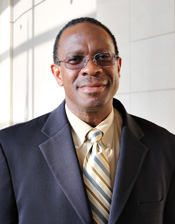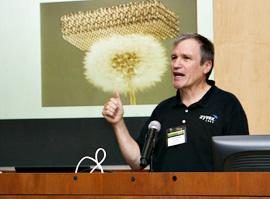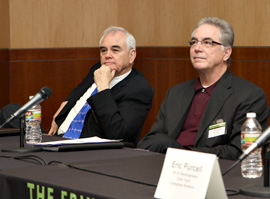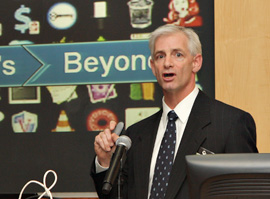Could one of the world’s oldest tools become obsolete in the progression of technology? A recent panel discussion of the next 25 years raised the possibility that the common hammer may go the way of horse and buggy.
“Hammer and nails will probably go by the wayside,” said John Randall, president of Zyvex Corp. He said his sister company is using a specific type of carbon nanotube to bond two aluminum plates together.

Art George, senior vice president of Texas Instruments, was among the panelists who discussed the possible technological advances of the next quarter century.
The example was one of many discussed at Monday’s “25 Years of Technology Show and Tell” event at UT Dallas. The next quarter-century in engineering could also bring voice-activated cell phones worn as jewelry or clothing, video projection onto any surface including the retina of the human eye, or cars that communicate, panelists said.
The event, held in recognition of the 25th anniversary of the Erik Jonsson School of Engineering and Computer Science, brought leaders of companies such as General Motors, Plexon, Texas Instruments Inc., Tyler Tech and Zyvex Labs. The company representatives talked about their products from 25 years ago as well as those predicted for the future. Twenty-five registered students were also given the opportunity to see the company facilities at a later time.
Craig Eppling, regional communications manager for General Motors, said dashboards of the future will be configured by drivers. The vehicles will likely be designed by people in different countries, he said. And vehicles will one day talk to each other to avoid collisions.
“They are going to monitor cars coming up to intersections, (to determine) how close they are and what speed they are going,” he said.
“What I love most about the industry is there will be great engineers like you who define that future.”
Art George,
senior vice president,
Texas Instruments
Communities will also one day be able to coordinate the charging of electric cars to avoid overloading generators. As part of the event, GM parked three new cars outside the engineering complex, including the Chevy Volt, which runs on electricity and gas.
Harvey Wiggins, president of Plexon, a leading producer of neurological research, said bioengineering and the fabrication of materials is making more equipment small enough to implant and interface with the nervous system. He hopes technology will soon be created to make it easier to lay small electrodes on the surface of the brain to get a more accurate read of neurological signals than the current, more intrusive technology of poking electrodes in the head.
Eric Purcell, vice president of development at Tyler Tech, one of the largest software developers in North Texas, said software is no longer created by one person developing applications. Software companies now include developers, designers and even artists who are less focused on the functionality of the application, but on fitting the user’s lifestyle. For example, artists included the look of wood grain on the screen of an electronic program that maintains documents for judges.
“We went from applications that were function-based that serviced clerical operations and made them efficient, to applications that were more role-based…centered around the user,” Purcell said.
Future applications will become increasingly customized, he said. “In the next 25, even five years, all of our applications will change so that we’re actually building software for an individual on the fly, even if they are one member of a 2,000-person statewide implementation.”
Several speakers noted the difficulty of predicting the future. Cell phones and cars have more computing power than the technology used to send people into space, panelists said.
“What I love most about the industry is there will be great engineers like you who define that future,” Art George, senior vice president at Texas Instruments Inc., told the students in the audience.
The Jonsson School anniversary celebration continues with a distinguished lecturer series at 11 a.m. Friday. John A. Rogers, founder professor of materials science and engineering at the University of Illinois at Urbana-Champaign, will speak on “Semiconductor Nanomaterials for Bio-Integrated Electronics.”
Other remaining National Engineers Week events include a Lego Explosion & Beyblade/Striker Challenge from 10 a.m. to 2 p.m. on Saturday. Anyone can participate. Entry forms and rules can be picked up at the Jonsson School’s Student Services front desk: ECS South 2.502. For questions, please contact Jacqueline Long at jalong@utdallas.edu or 972-883-4279.

John Randall, president of Zyvex Labs, said hammers may become tools of the past.

Harvey Wiggins (left), president of Plexon, spoke of improved medical equipment. Craig Eppling (right), regional communications manager for General Motors, described future vehicles that would one day communicate with each other.

Eric Purcell, vice president of development at Tyler Tech, said software customization will be taken to a whole new level.

Dr. Mark Spong, dean of the Erik Jonsson School of Engineering, took a look at one of the vehicles brought to the event by General Motors.